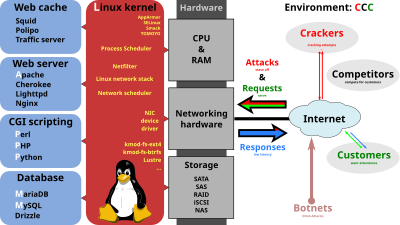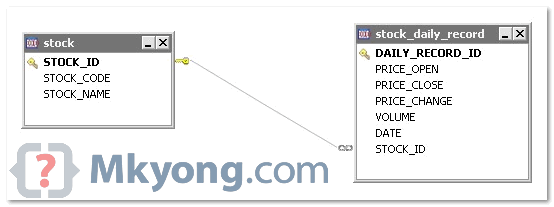2. create model classes to map for tables
we already have a Stock.java class which was made under package package com.mkyong.common;
first let's rename it to package com.mkyong.stock;
so we have better packaging structure
you have to do few modifications to support the one to many relationship
or else you can make new Stock.java in new package
---------
package com.mkyong.stock;
import static javax.persistence.GenerationType.IDENTITY;
import java.io.Serializable;
import javax.persistence.Column;
import javax.persistence.Entity;
import javax.persistence.GeneratedValue;
import javax.persistence.Id;
import javax.persistence.Table;
import javax.persistence.UniqueConstraint;
@Entity
@Table(name = "stock", catalog = "mkyong", uniqueConstraints = {
@UniqueConstraint(columnNames = "STOCK_NAME"),
@UniqueConstraint(columnNames = "STOCK_CODE") })
public class Stock implements Serializable {
/**
*
*/
private static final long serialVersionUID = 7029806795746254329L;
private Integer stockId;
private String stockCode;
private String stockName;
public Stock() {
}
public Stock(String stockCode, String stockName) {
this.stockCode = stockCode;
this.stockName = stockName;
}
@Id
@GeneratedValue(strategy = IDENTITY)
@Column(name = "STOCK_ID", unique = true, nullable = false)
public Integer getStockId() {
return stockId;
}
public void setStockId(Integer stockId) {
this.stockId = stockId;
}
@Column(name = "STOCK_CODE", unique = true, nullable = false, length = 10)
public String getStockCode() {
return stockCode;
}
public void setStockCode(String stockCode) {
this.stockCode = stockCode;
}
@Column(name = "STOCK_NAME", unique = true, nullable = false, length = 20)
public String getStockName() {
return stockName;
}
public void setStockName(String stockName) {
this.stockName = stockName;
}
}
-----------------------------------
for StockDailyRecord create another java class
Errors
----------
1. AppOneToMany.java stockDailyRecords.setStock(stock); was giving error, mapping to wrong Stock.java
previously on common package.
Reason : StockDailyRecord.java , I have imported import com.mkyong.common.Stock;
so the setter was mapped to com.mkyong.common.Stock;
2. Error in running application
------------------------------
Hibernate one to many (Annotation)
May 20, 2014 4:11:34 PM org.hibernate.annotations.common.Version
INFO: HCANN000001: Hibernate Commons Annotations {4.0.1.Final}
May 20, 2014 4:11:34 PM org.hibernate.Version logVersion
INFO: HHH000412: Hibernate Core {4.1.4.Final}
May 20, 2014 4:11:34 PM org.hibernate.cfg.Environment
INFO: HHH000206: hibernate.properties not found
May 20, 2014 4:11:34 PM org.hibernate.cfg.Environment buildBytecodeProvider
INFO: HHH000021: Bytecode provider name : javassist
May 20, 2014 4:11:34 PM org.hibernate.cfg.Configuration configure
INFO: HHH000043: Configuring from resource: /hibernate.cfg.xml
May 20, 2014 4:11:34 PM org.hibernate.cfg.Configuration getConfigurationInputStream
INFO: HHH000040: Configuration resource: /hibernate.cfg.xml
May 20, 2014 4:11:34 PM org.hibernate.internal.util.xml.DTDEntityResolver resolveEntity
WARN: HHH000223: Recognized obsolete hibernate namespace http://hibernate.sourceforge.net/. Use namespace http://www.hibernate.org/dtd/ instead. Refer to Hibernate 3.6 Migration Guide!
May 20, 2014 4:11:34 PM org.hibernate.cfg.Configuration doConfigure
INFO: HHH000041: Configured SessionFactory: null
Initial SessionFactory creation failed.org.hibernate.AnnotationException: Use of the same entity name twice: Stock
Exception in thread "main" java.lang.ExceptionInInitializerError
at com.mkyong.util.HibernateUtil.buildSessionFactory(HibernateUtil.java:20)
at com.mkyong.util.HibernateUtil.(HibernateUtil.java:8)
at com.mkyong.AppOneToMany.main(AppOneToMany.java:15)
Caused by: org.hibernate.AnnotationException: Use of the same entity name twice: Stock
at org.hibernate.cfg.annotations.EntityBinder.bindEntity(EntityBinder.java:402)
at org.hibernate.cfg.AnnotationBinder.bindClass(AnnotationBinder.java:586)
at org.hibernate.cfg.Configuration$MetadataSourceQueue.processAnnotatedClassesQueue(Configuration.java:3435)
at org.hibernate.cfg.Configuration$MetadataSourceQueue.processMetadata(Configuration.java:3389)
at org.hibernate.cfg.Configuration.secondPassCompile(Configuration.java:1341)
at org.hibernate.cfg.Configuration.buildSessionFactory(Configuration.java:1731)
at org.hibernate.cfg.Configuration.buildSessionFactory(Configuration.java:1782)
at com.mkyong.util.HibernateUtil.buildSessionFactory(HibernateUtil.java:16)
... 2 more
Caused by: org.hibernate.DuplicateMappingException: duplicate import: Stock refers to both com.mkyong.stock.Stock and com.mkyong.common.Stock (try using auto-import="false")
at org.hibernate.cfg.Configuration$MappingsImpl.addImport(Configuration.java:2582)
at org.hibernate.cfg.annotations.EntityBinder.bindEntity(EntityBinder.java:395)
... 9 more
-------------------
Reason : I have included two entries in the "hibernate.cfg.xml"
If you can see above , I have two entries for Stock.java and
Error itself gives asuggestion to
duplicate import: Stock refers to both com.mkyong.stock.Stock and com.mkyong.common.Stock (try using auto-import="false")
solution 1 :First i try with removing one record,
execute
------------------ i still hvae an error--------------
Hibernate one to many (Annotation)
May 20, 2014 4:18:52 PM org.hibernate.annotations.common.Version
INFO: HCANN000001: Hibernate Commons Annotations {4.0.1.Final}
May 20, 2014 4:18:52 PM org.hibernate.Version logVersion
INFO: HHH000412: Hibernate Core {4.1.4.Final}
May 20, 2014 4:18:52 PM org.hibernate.cfg.Environment
INFO: HHH000206: hibernate.properties not found
May 20, 2014 4:18:52 PM org.hibernate.cfg.Environment buildBytecodeProvider
INFO: HHH000021: Bytecode provider name : javassist
May 20, 2014 4:18:52 PM org.hibernate.cfg.Configuration configure
INFO: HHH000043: Configuring from resource: /hibernate.cfg.xml
May 20, 2014 4:18:52 PM org.hibernate.cfg.Configuration getConfigurationInputStream
INFO: HHH000040: Configuration resource: /hibernate.cfg.xml
May 20, 2014 4:18:52 PM org.hibernate.internal.util.xml.DTDEntityResolver resolveEntity
WARN: HHH000223: Recognized obsolete hibernate namespace http://hibernate.sourceforge.net/. Use namespace http://www.hibernate.org/dtd/ instead. Refer to Hibernate 3.6 Migration Guide!
May 20, 2014 4:18:52 PM org.hibernate.cfg.Configuration doConfigure
INFO: HHH000041: Configured SessionFactory: null
Initial SessionFactory creation failed.org.hibernate.AnnotationException: Use of @OneToMany or @ManyToMany targeting an unmapped class: com.mkyong.stock.Stock.stockDailyRecords[com.mkyong.stock.StockDailyRecord]
Exception in thread "main" java.lang.ExceptionInInitializerError
at com.mkyong.util.HibernateUtil.buildSessionFactory(HibernateUtil.java:20)
at com.mkyong.util.HibernateUtil.(HibernateUtil.java:8)
at com.mkyong.AppOneToMany.main(AppOneToMany.java:15)
Caused by: org.hibernate.AnnotationException: Use of @OneToMany or @ManyToMany targeting an unmapped class: com.mkyong.stock.Stock.stockDailyRecords[com.mkyong.stock.StockDailyRecord]
at org.hibernate.cfg.annotations.CollectionBinder.bindManyToManySecondPass(CollectionBinder.java:1204)
at org.hibernate.cfg.annotations.CollectionBinder.bindStarToManySecondPass(CollectionBinder.java:735)
at org.hibernate.cfg.annotations.CollectionBinder$1.secondPass(CollectionBinder.java:670)
at org.hibernate.cfg.CollectionSecondPass.doSecondPass(CollectionSecondPass.java:66)
at org.hibernate.cfg.Configuration.originalSecondPassCompile(Configuration.java:1591)
at org.hibernate.cfg.Configuration.secondPassCompile(Configuration.java:1366)
at org.hibernate.cfg.Configuration.buildSessionFactory(Configuration.java:1731)
at org.hibernate.cfg.Configuration.buildSessionFactory(Configuration.java:1782)
at com.mkyong.util.HibernateUtil.buildSessionFactory(HibernateUtil.java:16)
... 2 more
-----------------------
Reason to happen this error
http://stackoverflow.com/questions/4956855/hibernate-problem-use-of-onetomany-or-manytomany-targeting-an-unmapped-clas
Your annotations look fine. Here are the things to check:
make sure the annotation is javax.persistence.Entity, and not org.hibernate.annotations.Entity. The former makes the entity detectable. The latter is just an addition.
if you are manually listing your entities (in persistence.xml, in hibernate.cfg.xml, or when configuring your session factory), then make sure you have also listed the ScopeTopic entity
make sure you don't have multiple ScopeTopic classes in different packages, and you've imported the wrong one.
So I deleted all the classes Stock.java which was previously put inside to com.mkyong.common; package
I have been using it's references and I deleted all the references from App2.java and StockDetail.java classes
and it's runs fine
----------------
output will be
---------------
Hibernate: insert into mkyong.stock (STOCK_CODE, STOCK_NAME) values (?, ?)
Hibernate: insert into mkyong.stock_daily_record (DATE, PRICE_CHANGE, PRICE_CLOSE, PRICE_OPEN, STOCK_ID, VOLUME) values (?, ?, ?, ?, ?, ?)
Done
-----------
if you need full detail output
-------------------------------------------------------------
Hibernate one to many (Annotation)
May 20, 2014 4:55:34 PM org.hibernate.annotations.common.Version
INFO: HCANN000001: Hibernate Commons Annotations {4.0.1.Final}
May 20, 2014 4:55:34 PM org.hibernate.Version logVersion
INFO: HHH000412: Hibernate Core {4.1.4.Final}
May 20, 2014 4:55:34 PM org.hibernate.cfg.Environment
INFO: HHH000206: hibernate.properties not found
May 20, 2014 4:55:34 PM org.hibernate.cfg.Environment buildBytecodeProvider
INFO: HHH000021: Bytecode provider name : javassist
May 20, 2014 4:55:34 PM org.hibernate.cfg.Configuration configure
INFO: HHH000043: Configuring from resource: /hibernate.cfg.xml
May 20, 2014 4:55:34 PM org.hibernate.cfg.Configuration getConfigurationInputStream
INFO: HHH000040: Configuration resource: /hibernate.cfg.xml
May 20, 2014 4:55:34 PM org.hibernate.internal.util.xml.DTDEntityResolver resolveEntity
WARN: HHH000223: Recognized obsolete hibernate namespace http://hibernate.sourceforge.net/. Use namespace http://www.hibernate.org/dtd/ instead. Refer to Hibernate 3.6 Migration Guide!
May 20, 2014 4:55:34 PM org.hibernate.cfg.Configuration doConfigure
INFO: HHH000041: Configured SessionFactory: null
May 20, 2014 4:55:35 PM org.hibernate.service.jdbc.connections.internal.DriverManagerConnectionProviderImpl configure
INFO: HHH000402: Using Hibernate built-in connection pool (not for production use!)
May 20, 2014 4:55:35 PM org.hibernate.service.jdbc.connections.internal.DriverManagerConnectionProviderImpl configure
INFO: HHH000115: Hibernate connection pool size: 20
May 20, 2014 4:55:35 PM org.hibernate.service.jdbc.connections.internal.DriverManagerConnectionProviderImpl configure
INFO: HHH000006: Autocommit mode: false
May 20, 2014 4:55:35 PM org.hibernate.service.jdbc.connections.internal.DriverManagerConnectionProviderImpl configure
INFO: HHH000401: using driver [com.mysql.jdbc.Driver] at URL [jdbc:mysql://localhost:3306/mkyong]
May 20, 2014 4:55:35 PM org.hibernate.service.jdbc.connections.internal.DriverManagerConnectionProviderImpl configure
INFO: HHH000046: Connection properties: {user=root, password=****}
May 20, 2014 4:55:35 PM org.hibernate.dialect.Dialect
INFO: HHH000400: Using dialect: org.hibernate.dialect.MySQLDialect
May 20, 2014 4:55:35 PM org.hibernate.engine.jdbc.internal.LobCreatorBuilder useContextualLobCreation
INFO: HHH000423: Disabling contextual LOB creation as JDBC driver reported JDBC version [3] less than 4
May 20, 2014 4:55:35 PM org.hibernate.engine.transaction.internal.TransactionFactoryInitiator initiateService
INFO: HHH000399: Using default transaction strategy (direct JDBC transactions)
May 20, 2014 4:55:35 PM org.hibernate.hql.internal.ast.ASTQueryTranslatorFactory
INFO: HHH000397: Using ASTQueryTranslatorFactory
Hibernate: insert into mkyong.stock (STOCK_CODE, STOCK_NAME) values (?, ?)
Hibernate: insert into mkyong.stock_daily_record (DATE, PRICE_CHANGE, PRICE_CLOSE, PRICE_OPEN, STOCK_ID, VOLUME) values (?, ?, ?, ?, ?, ?)
Done
------------------------------------------------

